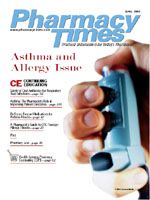Publication
Article
Pharmacy Times
Combating Chronic Obstructive Pulmonary Disease
Author(s):
Chronic obstructive pulmonary disease (COPD), the fourth leading cause of death in the United States, will probably advance into the top 3 by 2020.1 COPD includes chronic bronchitis with airway limitations, chronic bronchiolitis, and emphysema. Depression and anxiety are common comorbidities, as are systemic inflammation and declining skeletal muscle mass late in the disease process. These disorders confound medical outcome.2 Severely ill patients generally struggle emotionally, socially, and physically.3 This worldwide problem prompted experts to develop the Global Initiative for Chronic Obstructive Lung Disease (GOLD) standards (www.goldcopd.com).4 Pharmacists will find the tools available on that Web site most useful.
Cigarette smoking is the main cause of this breath-robbing disease; approximately 80% of COPD cases are smoking- related.5 Smoking cessation or reduction substantially reduces COPD risk and/or rate of progression. Routine spirometry can identify COPD in its early stages, but clinicians frequently fail to perform this simple test in high-risk patients. COPD currently is staged based on airflow limitation, although the extent of limitation correlates only partially with symptom presence (Table).4,6
Treatment
Pharmacologic treatment of COPD is a long-term proposition. Effective agents reduce inflammation, improve pulmonary function and quality of life, and reduce the frequency of acute exacerbations. The authors of GOLD consider bronchodilators, such as the long-acting inhaled beta2 agonists salmeterol and formoterol, the foundation of therapy. These agents significantly improve symptoms, exercise capacity, and health status in patients with COPD.4,7,8
Anticholinergics, such as ipratropium bromide and tiotropium, are other first-line agents that can be used alone or in combination with long-acting or short-acting beta2 agonists. Once-daily tiotropium improves dyspnea in a magnitude similar to or greater than beta2 agonists.9-12 In patients with more severe COPD, bronchodilator therapy improves expiratory lung emptying and exercise tolerance.13,14 Both longacting beta2 agonists and long-acting anticholinergic agents also reduce exacerbation frequency.8,10-12
Clinicians prescribe methylxanthines primarily for their effects on pulmonary arterial pressure, pulmonary vascular resistance, renal blood flow, and glomerular filtration rate. Their use is controversial. In more severe COPD, theophyllines produce bronchodilation, with variable effects on exercise tolerance and symptoms.15-20 Several studies have shown that combining beta2 agonists, anticholinergic agents, and theophylline can improve lung function and health status.21-28
If appropriate multiple bronchodilator therapy fails to move the forced expiratory volume in 1 second to more than 50% predicted, and if exacerbations continue, inhaled corticosteroids can help. The combination of glucocorticoids and long-acting beta2 agonists is more effective than either alone.29-33
Exacerbations
Acute exacerbations are characterized by increased cough or sputum production, worsening of dyspnea, wheezing, chest tightness, or changes in sputum purulence, requiring treatment changes.33,34 For severely ill patients, acute exacerbations are major social and emotional burdens.35-37 They can be life-threatening and are often complicated by respiratory failure.38 Connors and colleagues39 studied 1016 patients admitted to the hospital with severe COPD exacerbations. Half of these patients required intensive care, and 35% required mechanical ventilation. Mortality was 11% during hospitalization, and 33% and 50% within 6 months and 2 years, respectively.
Viral and bacterial infection or air pollutants are the most frequent causes of exacerbation?which underscores the need for adult vaccinations. More compromised patients host infections more frequently, and the infections tend to be more tenacious.40,41 Viral infections of the lower respiratory tract can damage the airway epithelium directly, further complicating the patient's condition.42 Rhinoviruses are the most common causes of infection.43 Air pollution, especially particulate air pollution, also is associated with acute exacerbations.44-47
The management of exacerbations requires increased bronchodilation and, sometimes, antibiotics. Compared with placebo, oral and nebulized corticosteroids for 7 to 10 days accelerate the rate of lung function improvement, and oral corticosteroids can shorten hospital stay.48-52 Supplemental oxygen therapy is common, but it can inadvertently induce hypercapnia (elevated serum carbon dioxide) and respiratory acidosis.
Edema and cor pulmonale are common outcomes of COPD. Exacerbations and extensive edema compromise renal blood flow. If hypercapnia persists or worsens, vasodilation, retention of sodium and water, and edema will also remain or worsen. Diuretics aggravate this cycle by further stimulating sodium loss and compensatory renin activation.
Ventilatory Failure in COPD
Respiratory failure is a common consequence of severe COPD. Clinicians try to prevent tissue hypoxia and hypercapnia and to control acidosis while reversing the cause of the exacerbation. Drugs, then noninvasive ventilation as soon as the patient develops moderate respiratory acidosis,53 then endotracheal intubation and mechanical ventilation are considered sequential interventions in acute cases. Long-term oxygen therapy is to be expected in patients with chronic stable COPD; when used for at least 15 hours daily, it can extend life.54
Weight loss is a common terminal complication. Loss of more than 40% of metabolizing and contracting tissue is incompatible with life. Serial measurements of body mass index will identify progressive involuntary weight loss. It is considered to be clinically relevant when it exceeds 5% over a month or 10% over 6 months. It also predicts mortality in COPD patients.55-57
The GOLD guidelines recommend the addition of pulmonary rehabilitation (exercise, nutritional counseling, education) for patients and their families once patients progress from stage 1.4 The goal is achieving and maintaining the patient's independence and community functioning.58 Each patient's rehabilitation program must address unique physiopathologic and psychopathologic impairment. Most COPD patients are unable to exercise strenuously but will physiologically adapt to endurance training with time. Health status will improve with exercise.59
Surgery
Should COPD progress, lung-volume reduction surgery sometimes is performed. Studies have confirmed its benefit, although it is not without risk.60,61 Lung transplantation, or complete replacement of the diseased and nonfunctioning lungs, can improve pulmonary function and exercise tolerance, but few COPD patients are good candidates, and fewer donor lungs are available.62
Conclusion
The prevalence, mortality, and premature morbidity of COPD are escalating. Increased public awareness, early diagnosis and intervention, and secondary prevention by primary care providers may help reverse the trend.
Ms. Wick is a senior clinical research pharmacist at the National Cancer Institute, National Institutes of Health. The views expressed are those of the author and not those of any governmental agency.

Newsletter
Stay informed on drug updates, treatment guidelines, and pharmacy practice trends—subscribe to Pharmacy Times for weekly clinical insights.






